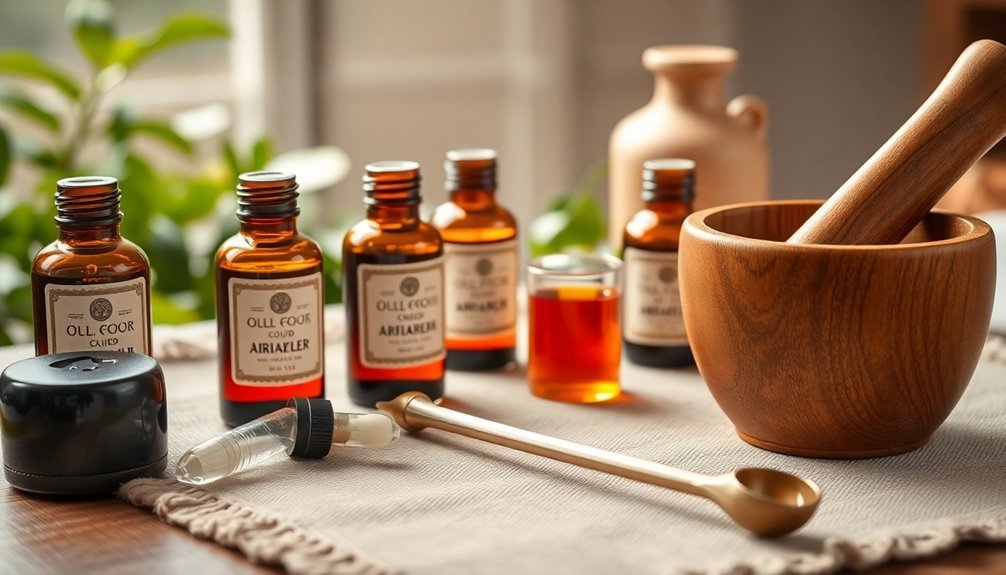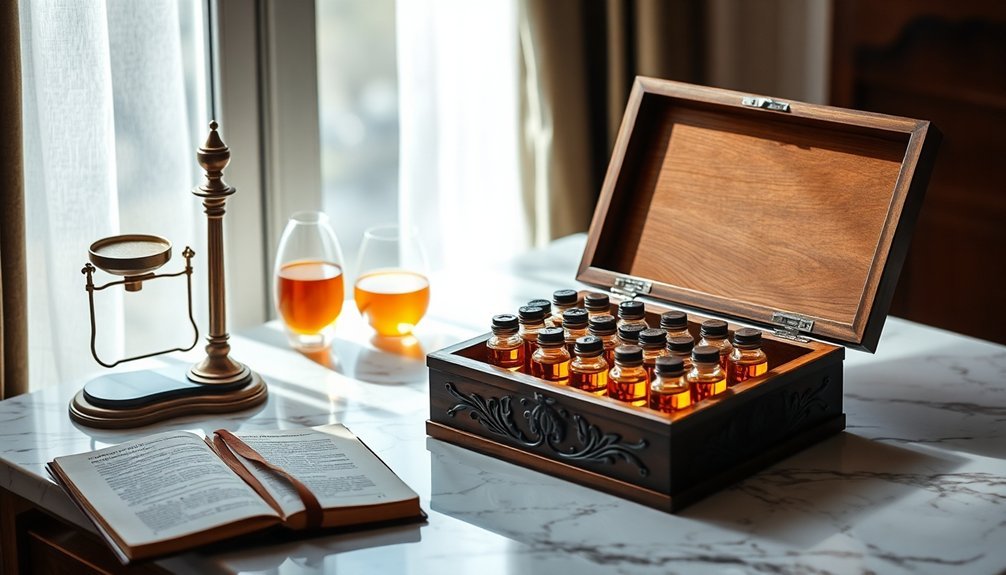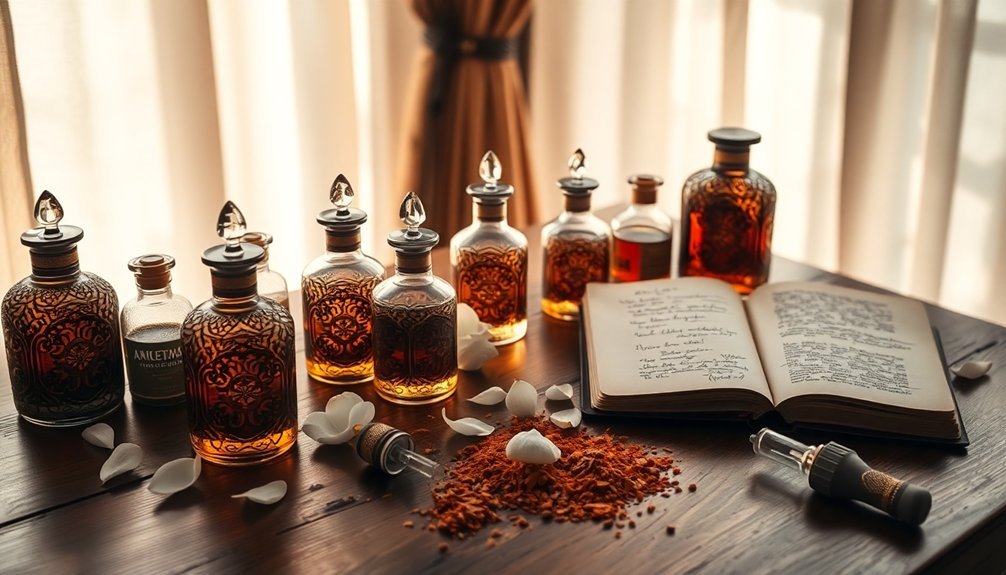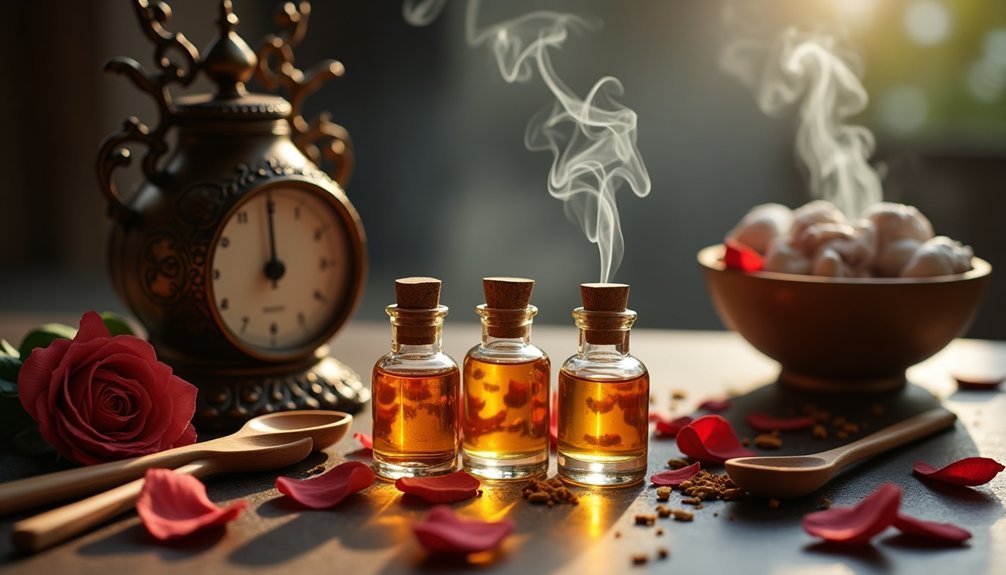To create stunning oud fragrances at home, you'll need precise tools like a decigram scale, quality pipettes, and dark amber bottles for storage. Start with premium oud oil from wild agarwood, then blend using proven ratios like 1:1 or 2:1:1 with complementary notes such as rose, jasmine, or spices. Store your creations in a cool, dark place between 60-80°F, and allow them to age properly. These foundational steps reveal the gateway to mastering professional-level oud blending.
Essential Tools and Materials for Oud Blending

Creating your own oud fragrances requires a precise set of tools and high-quality materials.
You'll need a reliable decigram scale for accurate measurements and a dedicated blending device to mix your perfume components. Given oud's viscous nature, you'll want to stock both disposable plastic pipettes and alternative tools like glass or metal pipettes for thicker oils.
Your material list should include various types of oud oil or resin as your foundation, complemented by woody essential oils like cedarwood and sandalwood. For enhanced woody notes, consider adding timber silk isoe to your base ingredients.
Don't forget essential base notes such as musk, amber, and vanillin to add depth. You'll also want to include resin oils like frankincense and myrrh, along with supporting ingredients such as cypriol and ethylene brassylate.
Keep stirring rods handy for thorough mixing of your blends.
Understanding Oud Oil Quality and Selection
Once you've assembled your blending tools, selecting the right oud oil becomes your next major consideration.
Begin by examining the oil's source – wild agarwood produces superior resins compared to cultivated varieties. Only about 7 in 100 trees naturally contain oud resin in the wild, making these sources particularly precious. Look for oils from old, dead trees found in Southeast Asian forests, particularly the prestigious Kyara or sinking-grade wood.
Pay attention to the oil's origin, as regional differences greatly impact the aroma profile. Oils from Assam, Cambodia, and Laos each offer unique characteristics based on their terroir.
When purchasing, verify the distillation method – artisanal processes typically yield better results than commercial ones.
Also consider the oil's age, as mature oud develops more complex and refined notes over time. If possible, opt for properly aged oils stored under ideal conditions for the best blending results.
Basic Ratio Techniques for Oud Mixing

When you're just starting to blend oud fragrances, begin with a straightforward 1:1 ratio between two oils to understand their interaction.
You can then progress to layering multiple notes by introducing a third oil at varying proportions, such as 2:1:1 or 3:2:1.
Testing different ratios helps you discover the perfect balance between the intense oud base and complementary fragrances while developing your signature scent. Using traditional steam distillation techniques ensures the purest essence of each oil in your blend.
Start Simple: 1:1 Ratio
The golden rule of oud blending starts with understanding why a 1:1 ratio typically won't work. Oud's powerful and dominant nature requires a more nuanced approach to achieve a balanced fragrance. Instead of equal parts, you'll want to use a lighter hand with this precious ingredient.
Start with a smaller ratio of oud to your secondary ingredient. For example, when blending with roses, try a 1:4 ratio (25% rose to 75% oud), especially if you're using Bulgarian or Turkish roses.
You can always adjust upward by adding more of the secondary ingredient if needed. Use the drop-by-drop method to maintain precise control over your blend, and keep detailed notes of your measurements.
Layering Multiple Notes
Successfully layering multiple notes with oud requires understanding the fragrance pyramid and proper ratio techniques.
When blending oud fragrances, start with your base notes first, as they'll provide the foundation for your creation. You'll want to apply stronger scents initially, then build up with lighter notes to create a balanced composition.
- Begin with a 2:1 ratio of oud to oriental base notes like vanilla or musk for a solid foundation
- Add woody elements such as sandalwood or cedar at a 1:1 ratio to enhance depth
- Layer floral heart notes at a 1:2 ratio to add complexity without overwhelming the oud
- Finish with subtle citrus top notes at a 1:3 ratio for brightness and liveliness
Remember to test your combinations on paper first, and don't rush the process – good oud blending requires patience and precision.
Testing Different Oil Proportions
Building on your knowledge of layering notes, mastering oil proportions will determine the success of your oud blend. Start with a conservative rose-to-oud ratio of 1:4 (20%) and adjust based on your preferred intensity. You'll need to take into account the specific rose variety you're using, as each type requires different proportions.
| Rose Type | Recommended Ratio |
|---|---|
| Basic Rose | 20% (1:4) |
| Taifi Rose | 25-30% (1:3) |
| Light Rose | 5-15% (1:8) |
| Turkish Rose | 15-20% (1:5) |
| Bulgarian Rose | 20-25% (1:4) |
Test your blends using the Jean Carl's method by counting drops and documenting each combination. Use separate beakers for different ratios and let them settle before evaluating. Remember that aged oud typically requires less volume due to its increased potency, so adjust accordingly.
Complementary Notes That Enhance Oud
When you're ready to elevate your Oud fragrance, start by exploring the most essential floral companions: rose and jasmine.
You'll find these florals add a soft, elegant dimension that perfectly balances Oud's bold character, while creating a harmonious blend that's suitable for daytime wear.
After mastering floral pairings, you can venture into spice blends, incorporating warm notes like cinnamon, saffron, and cardamom to create rich, exotic combinations.
Essential Floral Pairings First
To create a balanced oud fragrance at home, you'll want to start with complementary floral notes that enhance oud's distinctive character.
Begin with rose notes, which naturally complement oud's spicy profile while adding elegance and depth. Jasmine helps balance intensity and creates a rounded finish, while peony introduces a delicate, romantic softness that works beautifully with suede notes.
- Rose pairs seamlessly with other florals and creates a luxurious, velvety foundation
- Jasmine softens bold oud while enhancing overall complexity
- Peony adds a powdery quality and makes floral bouquets airier
- Heavy florals like those found in Orangery create unique, atmospheric combinations
When blending, remember that florals can lighten oud's intensity, making your creation suitable for daytime wear while maintaining sophistication.
Spice Blends With Oud
Spices play an essential role in elevating your oud fragrance to new heights of sophistication. When blending with oud, you'll find that cinnamon adds warm, exotic tones while enhancing its natural depth.
Clove creates a bold, aromatic combination, and cardamom introduces vibrant spiciness that complements oud's earthy character.
To achieve the perfect blend, start by applying lighter notes before introducing heavier spices. Focus on your pulse points – wrists, neck, and behind the ears – for ideal projection.
You'll want to layer your fragrance strategically: combine cardamom and pink pepper in the top notes, integrate clove in the heart, and let oud shine in the base alongside other woods and musks.
Don't forget to take into account your skin type, as this affects how the spices interact with the fragrance.
Proper Storage and Aging Methods

Proper storage and aging techniques play four essential roles in maintaining your oud attar's quality and longevity.
You'll need to store your precious oud in dark amber glass bottles, keeping them in a cool, dark place at temperatures between 60-80°F. Avoid bathrooms and kitchens due to humidity, and never expose your attar to direct sunlight or UV rays.
- Store bottles in closed drawers or cabinets away from windows
- Handle bottles with clean hands and keep caps tightly sealed
- Use dark glass containers instead of clear or plastic ones
- Allow fresh oud to cure and age properly to remove moisture
Your oud attar needs proper aging to develop complexity and stability.
Through careful aging, you'll notice sharper notes becoming more refined, and with proper storage, your oud can maintain its magnificent fragrance for decades.
Testing and Adjusting Your Oud Blend
Once your oud blend has aged and settled, the real artistry begins with testing and fine-tuning. You'll need to identify imperfections through skin testing and raw material analysis, then make precise adjustments to achieve the perfect balance.
| Aspect | Method | Goal |
|---|---|---|
| Notes | Layer testing | Harmonious progression |
| Balance | Minimal adjustments | Even distribution |
| Enhancement | Add complementary ingredients | Depth and complexity |
| Integration | Maturation check | Seamless blending |
Start by testing small dilutions on skin strips to identify any unwanted notes. Make subtle concentration adjustments, focusing on one element at a time. You can enhance your blend by incorporating complementary ingredients like vetiver or sandalwood. Don't forget to document each change and allow time for the modifications to settle before making further adjustments. Seek feedback from others to ascertain your blend achieves its intended character.
Master Blending Recipes for Signature Scents

Creating signature Oud scents requires mastering a selection of proven blending recipes that showcase the wood's complex character.
You'll want to start with a high-quality Oud base like Black Agar or Oud Samrat, then layer complementary ingredients to achieve your desired profile.
For a classic oriental blend, combine your Oud base with cedarwood and frankincense, adding a touch of vanillin for sweetness. If you're seeking a more contemporary scent, try pairing Oud with rose and bergamot, balanced by soft musk notes.
- Traditional Oriental: Mix Oud base (40%) with cedarwood (30%), frankincense (20%), and vanillin (10%)
- Modern Floral: Combine Oud base (35%) with rose (25%), bergamot (20%), and musk (20%)
- Spiced Leather: Blend Oud base (45%) with leather notes (25%), cardamom (15%), and saffron (15%)
- Fresh Woody: Layer Oud base (30%) with sandalwood (30%), vetiver (20%), and cashmere (20%)
Frequently Asked Questions
How Long Does Homemade Oud Perfume Last on Skin Compared to Commercial Versions?
Your homemade oud perfume can last 4-6 hours on skin, while commercial versions typically last 2-4 hours. However, if you use high-quality ingredients and proper fixatives, your blend could last up to 12 hours.
Can Natural Oud Oil Cause Allergic Reactions When Used in DIY Blends?
Yes, you can experience allergic reactions to natural oud oil in DIY blends. You'll need to watch for red, itchy rashes where you apply it, since it can trigger skin sensitization even in pure forms.
What Percentage of Real Oud Should Beginners Use in Their First Blend?
Start with just 1-2% real oud in your first blend, as it's extremely potent. You'll want to dilute it carefully and can gradually increase the percentage once you're comfortable with its strength.
Does Room Temperature Affect the Blending Process of Oud-Based Fragrances?
Yes, room temperature considerably affects your oud blending process. You'll notice faster evaporation rates in warm rooms, which can impact how oils mix. It's best to blend in a cool, controlled environment.
Why Do Some Oud Blends Smell Different on Different People?
Your unique skin chemistry, body temperature, and personal factors make oud fragrances smell different on you. When the oud interacts with your skin, it creates a personalized scent that's distinctly yours.
In Summary
Now that you've mastered these seven essential secrets of oud blending, you're ready to create your own signature fragrances at home. Remember to start with small batches, keep detailed notes of your successful blends, and don't be afraid to experiment. With practice and patience, you'll develop a deeper understanding of how oud interacts with other notes. Trust your nose and enjoy your journey into the art of oud perfumery.





Leave a Reply